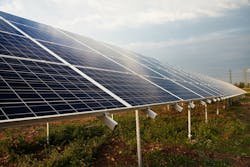Rivaling silicon-based materials, perovskite has thrown its proverbial hat into the ring to ultimately develop more efficient solar cells. However, one issue persists: the material’s chemical instability.
In a study by a team at Queen Mary University of London (UK), researchers have developed a new process for creating perovskite materials that are more stable, and potentially exhibit more efficiency for solar cells. The instability of perovskite—a mineral consisting largely of calcium titanate—materials stems from its extreme sensitivity to light, moisture, and oxygen, which can prompt rapid degradation.
There is hope in a particular type of perovskite material: formamidinium perovskite (FAPbI3). According to the researchers, its “pure, black-colored crystal structure … is more chemically stable than many other perovskites.” Additionally, the optical properties of FAPbI3 make it more proficient at absorbing light rather than being damaged by it. And scientists have found this specific type of perovskite—particularly the black, stable form of this material—can produce electricity more efficiently in solar cells.
But actually creating this material for solar cell use has been a challenge, regardless of its stability, as it can often instead produce a “yellow phase that isn’t suitable for solar cells.”
As noted in the study, another challenge is that “crystallization of phase-pure FAPbI3 conventionally requires high-temperature thermal annealing” (around 300°F), which can strain those crystals within the material—this tends to favor that unsuitable yellow phase. Including small amounts of various additives have been explored in forming FAPbI3 material in other studies, according to the researchers, but “it can be very hard to control the uniformity and amounts of these additives when making solar cells at a very large scale.” The team notes, too, that scientists have yet to identify long-term impacts.
The Queen Mary University team is working to understand such impacts and alleviate those challenges. In their study, published in Advanced Materials, they found that aerosol-assisted crystallization can convert the unstable yellow into the more stable black at just over 200°F, “using precursor solutions containing only lead iodide and formamidinium iodide with no chemical additives.” The lower temperature was also shown to “help relax the crystals within the material.”
“Pure [FAPbI3] could produce perovskite solar cells that are more efficient and stable than those made with other commonly used hybrid perovskites based on methylammonium,” says researcher Dr. Joe Briscoe, Reader in Energy Materials and Devices and program director for Sustainable Energy Engineering at Queen Mary, citing the currently most widely used material for solar cells: crystalline silicon.
He adds that as the team’s new process “uses an ‘inverted’ perovskite solar cell structure and lower annealing temperature [that] also makes it very suitable for making flexible solar cells on plastic.” Other potential applications include for manufacturing clothing and vehicles.
About the Author
Justine Murphy
Multimedia Director, Digital Infrastructure
Justine Murphy is the multimedia director for Endeavor Business Media's Digital Infrastructure Group. She is a multiple award-winning writer and editor with more 20 years of experience in newspaper publishing as well as public relations, marketing, and communications. For nearly 10 years, she has covered all facets of the optics and photonics industry as an editor, writer, web news anchor, and podcast host for an internationally reaching magazine publishing company. Her work has earned accolades from the New England Press Association as well as the SIIA/Jesse H. Neal Awards. She received a B.A. from the Massachusetts College of Liberal Arts.

